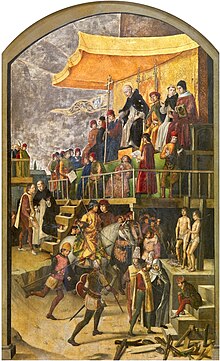Ad extirpanda

Ad extirpanda (named for its Latin incipit) was a papal bull, promulgated on May 15, 1252 by Pope Innocent IV, which explicitly authorized (and defined the appropriate circumstances for) the use of torture by the Inquisition for eliciting confessions from heretics.[1]
Canonical status
It was confirmed by Pope Alexander IV on November 30, 1259, and by Pope Clement IV on November 3, 1265. At the time of the bull, the cleric performing the questioning was forbidden to be present at the time of the actual torture, on pain of irregularity; however, this requirement was waived on April 27, 1260 when Alexander IV authorized inquisitors to absolve one another of this irregularity, and further on August 2, 1262 when Pope Urban IV renewed this permission in a manner that was widely interpreted as authorizing examination within the torture chamber itself.[1]
Content
The bull argued that as heretics are "murderers of souls as well as robbers of God’s sacraments and of the Christian faith...", they are "to be coerced—as are thieves and bandits—into confessing their errors and accusing others, although one must stop short of danger to life or limb." [2] The following parameters were placed on the use of torture:[1]
- that it did not cause loss of life or limb (citra membri diminutionem et mortis periculum)
- that it was used only once
- that the Inquisitor deemed the evidence against the accused to be virtually certain
The requirement that torture only be used once was effectively meaningless in practice as it was interpreted as authorizing torture with each new piece of evidence that was produced and by considering most practices to be a continuation (rather than repetition) of the torture session (non ad modum iterationis sed continuationis).[1]
The bull conceded to the State a portion of the property to be confiscated from convicted heretics.[3] The State in return assumed the burden of carrying out the penalty. The relevant portion of the bull read: "When those adjudged guilty of heresy have been given up to the civil power by the bishop or his representative, or the Inquisition, the podestà or chief magistrate of the city shall take them at once, and shall, within five days at the most, execute the laws made against them."[4]
Notes
- ^ a b c d
 "Inquisition" in the 1913 Catholic Encyclopedia.
"Inquisition" in the 1913 Catholic Encyclopedia.
- ^ Ad extirpanda, quoted at The Roman Theological Forum
- ^ New Schaff-Herzog Encyclopedia: II. "The Inquisition in the Middle Ages". Concise historical context of Ad extirpanda
- ^ Kline, Austin. "Chronology of Medieval Christianity." About.com.
